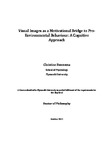Visual Images as a Motivational Bridge to Pro-Environmental Behaviour: A Cognitive Approach
| dc.contributor.supervisor | Pahl, Sabine | |
| dc.contributor.author | Boomsma, Christine | |
| dc.contributor.other | Faculty of Science and Engineering | en_US |
| dc.date.accessioned | 2013-06-21T08:01:07Z | |
| dc.date.available | 2013-06-21T08:01:07Z | |
| dc.date.issued | 2013 | |
| dc.date.issued | 2013 | |
| dc.identifier | 10254261 | en_US |
| dc.identifier.uri | http://hdl.handle.net/10026.1/1546 | |
| dc.description.abstract |
Communicating climate change and other long-term environmental issues to the wider public is a challenging process involving many barriers to action. Visualisations have the ability to overcome these barriers. Furthermore, the benefits of visual images over verbal information have been supported. However, there is a lack of research on how visual images can motivate behaviour. Based on Elaborated Intrusion theory, it is proposed that visual images can be internalised as mental images which can act as a ‘motivational bridge’ for pro-environmental behaviour. Six studies exposed participants to visual pro-environmental messages. Throughout all studies images were internalised as mental images, associated with intrusive thoughts. Consistently, mental images were strongly associated with pro-environmental goals and behaviour change (self-report and actual). Also, interfering with visual mental imagery, using cognitive tasks, reduced self-reported behaviour change (Study 6). Overall, two motivational roles of mental imagery emerged: mental images can trigger pro-environmental goals and can strengthen the relationship between pro-environmental goals and behaviour. The development, strength, and vividness of mental imagery depended on interacting individual and message characteristics. A vivid message was more effective when the message topic was relevant to the target individual (Study 2). Also, a message in line with existing values evoked more vivid mental imagery (Studies 2 to 6). A message could activate specific values as well if mental imagery was not interfered with (Study 5 and 6). And finally, positive and negative images were associated with different feelings, but could both be internalised and motivate behaviour (Study 3 and 6). A combined message could overcome the negative feelings associated with a fear appeal (Study 6). This thesis developed a theoretical framework, integrating approaches from social and cognitive psychology, which can help explain and predict responses to visual environmental messages. Six studies showed that the effect of a visual image on behaviour depends, among other factors, on its ability to trigger recurring mental imagery. Insights provide opportunities for designing evidence based visual pro-environmental messages. In turn this can maximise the impact visual messages have on changing people’s pro-environmental behaviour. | en_US |
| dc.language.iso | en | en_US |
| dc.publisher | University of Plymouth | en_US |
| dc.subject | Pro-environmental behaviour | en_US |
| dc.subject | Mental Imagery | en_US |
| dc.subject | Visual images | en_US |
| dc.subject | Behaviour change | en_US |
| dc.subject | Values | en_US |
| dc.title | Visual Images as a Motivational Bridge to Pro-Environmental Behaviour: A Cognitive Approach | en_US |
| dc.type | Thesis | |
| plymouth.version | Edited version | en_US |
| dc.identifier.doi | http://dx.doi.org/10.24382/4099 |
Files in this item
This item appears in the following Collection(s)
-
01 Research Theses Main Collection
Research Theses Main


